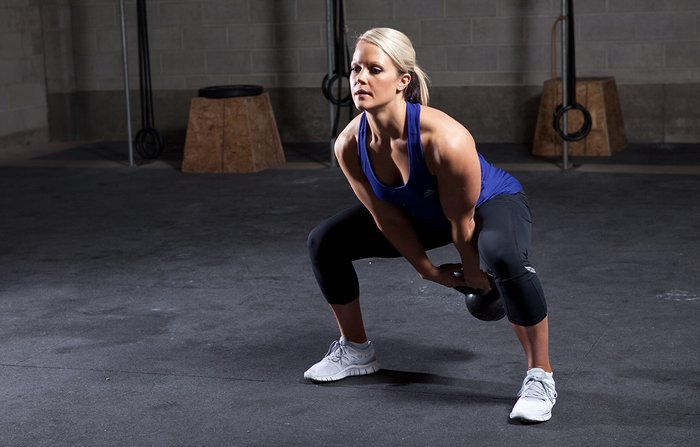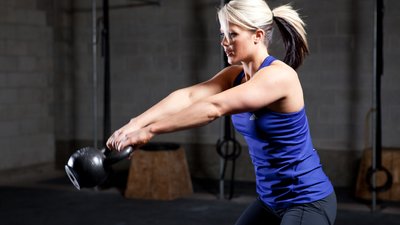In the last few years, kettlebells have gone from a popular but still somewhat esoteric strength-training obsession to being considered as a fundamental tool right alongside barbells, dumbbells, body weight, and machines. And it's no longer just fitness minimalists or "the kettlebell crowd" using them.
Case in point: After an interaction over social media, I recently had the opportunity to train Nicole Wilkins, a four-time IFBB Figure Olympia champion and a three-time IFBB Figure International champion, to dial in her form on the major kettlebell lifts. She had caught the bug—and in fact, she caught it bad enough that she decided to complete a StrongFirst Level I kettlebell certification—the most stringent and challenging certification out there.
This was a fascinating experience, and not only because Wilkins is such a big name. She's also been a competitive physique athlete since 2003, which means she has a level of muscularity, body awareness, and overall training experience that is truly elite. But for a period of four months, she dedicated upward of 80 percent of her training time to kettlebells—"in my garage, first thing in the morning without makeup or dressing up," she wrote on Instagram. The remaining training time was, well, bodybuilding. (She's still Nicole Wilkins, after all.)
Here's what we both learned during that time.
Lesson 1: There Are Many Ways to Add Kettlebells to Muscle-Building Workouts
Kettlebells have a reputation for creating a well-rounded athlete—strong, lean, and conditioned. But "jacked," not as much. But this isn't because it's not possible to incorporate kettlebells into a bodybuilding routine. On the contrary, there are plenty of ways to fit them in, depending on if you're in-season or off-season training and if you are looking to add muscle or lose fat.

When muscle gain is the goal, it's common to think of workouts in this sequence: warm-up, primary strength, secondary strength or volume, burnouts, and cardio. Bodybuilders have been following routines like that for decades, and there's no denying their effectiveness. Here's how to fit kettlebells into every part of it, for a shoulder day:
- Warm-up: Turkish get-ups to warm up both the shoulders, raise core temperature, and reinforce shoulder stability.
- Primary strength: Double-kettlebell military presses, performed rotating throughout the rep somewhat like an Arnold press.
- Secondary strength/volume: Single-arm standing or seated kettlebell presses, before a superset of dumbbell or cable lateral and front raises.
- Burnout and/or cardio: Kettlebell snatches, 5-8 per arm at the top of each minute, to burn serious calories and boost shoulder strength, or heavier kettlebell swings to hammer the rear delts while also building up the entire back side of your body.
Wilkins had done all manner of presses and pulls in her training, of course. But she found herself really enjoying the snatch in particular as her training for the certification got more serious.
"Kettlebell snatches and swings are just a great way to incorporate cardio into your routine and get your heart rate up," she told me.
Lesson 2: Kettlebells Reinforce Your Weak Links
One of the biggest advantages of training with kettlebells is the ability to increase both mobility and stability throughout the joints that need one or the other. This was a major appeal to me when I began getting serious about kettlebells six years ago, and I've seen it pay off with client after client ever since.
Maintaining joint mobility is a crucial part of staying injury free, because the inability to move through exercises with a full range of motion can be detrimental in your ability to get into the correct positions needed to lift safely. Joint stability, on the other hand, is essential for being able to safely bear the load you're lifting, without one of your "weak links" raising the white flag.
If you are looking to improve mobility and stability, the Turkish get-up is a great exercise to add to your routine. This single move has done so much for me that I titled my website and social handles "Get Up with Hannah."
Lesson 3: Kettlebells Are a Better Form of Cardio
After four months of training Wilkins for her kettlebell certification, she agreed that learning proper form was difficult at first—especially on a movement as complex as the get-up. But she also said it paid off in noticeable increases in her core strength. On the flipside, she also felt more powerful and explosive in her training after dialing in her technique on the kettlebell swing.
Variations on the swing are some of the best cardio there is, once you know what you're doing. It's a single movement using a single weight, but it can pay off in so many ways!
For one, of course, it can help you develop a stronger posterior chain—seriously, have you not heard of the term kettlebell booty yet?—but it also builds core strength, burns fat, increases your muscular and cardiovascular endurance, and burns immense amounts of calories.
Typical cardio workouts are just too boring, in my experience. The kettlebell swing isn't.
Lesson 4: Kettlebells Encourage Better Form on Fundamental Exercises
Let's say you prefer to use barbells or dumbbells for your main strength lifts. That's fine! But kettlebells should absolutely get consideration for your secondary lifts—the ones that are focused more on accumulating some solid volume and activating lots of muscle tissue. Here's why.
Let's look at the overhead press. The dumbbell is the tool of choice for most bodybuilders. However, once the weights get heavy, the long handle of the dumbbell places immense pressure on the hands and wrists, making it unstable and harder to push heavier loads overhead. If you use a kettlebell, the weight is more compact and the pressure will remain on the forearm allowing for a neutral or rotating grip. If you're like most people, you'll find you're able to move more weight through a greater range of motion, with a more natural movement pattern. That equals more muscle growth.
Many lifters have sworn off overhead presses under the assumption that their shoulders don't "like" them, but in my experience, some tell a different story once they've pressed a kettlebell. Ad once they build a strong press, they can further boost muscle building and fat loss by mixing the press into complexes.
The same goes for squats. No, you'll never be able to move as much weight using two kettlebells as a barbell front or back squat. But because it's front-loaded, you'll absolutely be able to squat deeper, and with better form. That's why strength coaches love the double-kettlebell front squat as a spine-friendly way to build athletes' quads, glutes, and hamstrings, while also demanding serious work from secondary and tertiary muscle groups such as the shoulders and core. It's a whole-body lift that can fit in any bodybuilder's leg day—even if you still do other leg work before or after it.
Lesson 5: Kettlebells Make You Focus on Being a Better Lifter
A common knock on kettlebells is that they're more technique-intensive than other gym equipment. But to those of us who have been through the wringer and been injured, this isn't a bad thing.
"Kettlebells may be more form-oriented than other tools used for strength training, but if you put in the work consistently you will get better and you will see progress," Wilkins told me.
Being nearly 40, and having done it all and seen it all, this new challenge appealed to her. When she started using kettlebells, she was frustrated and felt like a beginner. But as she got better at them, she got to feel that old thrill of progress again.
"As a trainer, I want to learn as many different things as possible," Wilkins wrote on Instagram. "This is why I did a triathlon last year and now I am expanding my knowledge with kettlebells. It challenges me physically and gives me new goals to reach! It also helps me better understand and relate to my clients, especially when they are frustrated with learning something new."
I can relate, as well. I started out as a beginner with kettlebells six years ago, after injuring my back in CrossFit so badly that my doctor told me to never lift again. Kettlebells gave me a way to train and feel strong and healthy again—and that ultimately led me to owning my movement in the weight room and feeling the thrill of lifting heavy again.
Whether you are a bodybuilder, powerlifter, CrossFitter, or just enjoy swinging kettlebells, we all want to stay healthy and be able to keep learning new ways to do what we love.
The goal of bodybuilding may be to increase muscle mass and decrease fat to look aesthetically your best, but by supplementing your training routines with kettlebells, you can develop more muscle, improve cardiovascular conditioning, build up muscular endurance, improve overall mobility and stability, and develop better body awareness while still reaching your goals.
Want to put kettlebells to the test in your own training? Try Ready for Anything, Volume 1: Beginner Kettlebell Workouts in BodyFit Elite. This repeatable two-week program will focus on the fundamentals and teach you new ways to program kettlebell work to see maximum payoff in the gym and in life!

